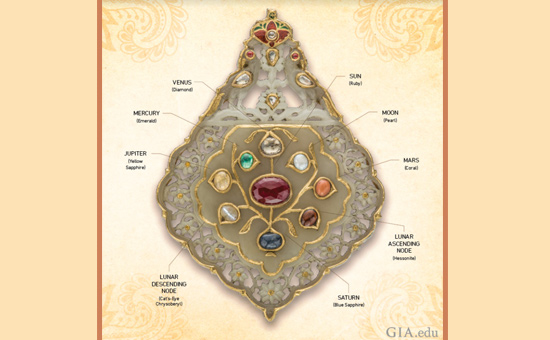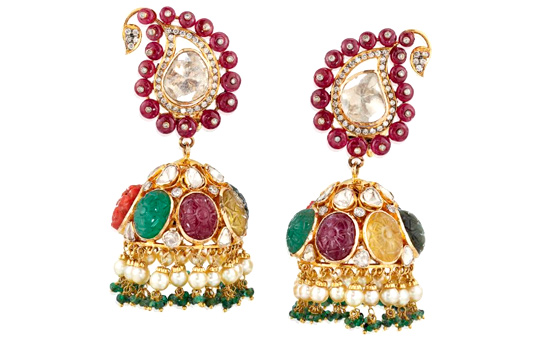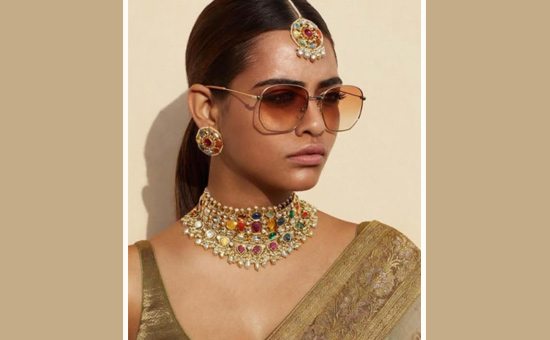-
Article explains
the concept of nine gems and gives their deities, how astrologers suggest
wearing of a particular gem and the nine gems in Chandragupta Maurya and Akbar’s
court.
Long
before diamonds became best friends even for the Indian girls, the jewellery-trousseau
of an Indian bride consisted of gold ornaments, a few silver trinkets and some ‘Jadau’
pieces.
Jadau was a generic term, in many
parts of India, for jewellery set with precious gemstones. It was common,
before diamonds started being promoted in the 1990s, for every bride
(irrespective of her religion/faith) to have at least one set of ear-studs, a finger-ring
or a pendant of ‘Navratna’ in her treasure chest. The affluent brides could
afford more elaborate pieces of Navratna like necklaces, bangles, bracelets, armlets
etc.
Nav+Ratna
or Nav+Ratan (colloquial version) literally means Nine-Gems. The concept of
Navratna or nine gems is closely associated with the ‘Nav+Graha’ or the nine
celestial/planetary deities of the Indic cosmology.
The gems
of Navratna and their corresponding deities are:
1. Maaṇikya/Manik (Ruby) for Surya (Sun)
2. Muktaaphalaṃ/Moti (Pearl) for Chandra (Moon)
3. Vidrumaṃ/Moonga (Red coral)
for Mangal
(Mars)
4. Maratakaṃ/Panna (Emerald)
for Budha (Mercury)
5. Pushparaajaṃ/Pukhraj (Yellow
sapphire) for Brihaspati
(Jupiter)
6. Vajraṃ/Heera (Diamond)
for Shukra
(Venus)
7. Neelaṃ (Blue sapphire)
for Shani (Saturn)
8. Gomeda (Hessonite)
for Rahu (the
ascending lunar node)
9. Vaiduryaṃ/Lahsuniya
(Cat's eye)
for Ketu (the
descending lunar node).
 Courtesy Sampat Jewellers.
Courtesy Sampat Jewellers.
Astrologers often prescribe one of these gems to a particular person, based on
their astrological charts, to gain the favour of a planetary deity. It acts as
an amulet that is believed to attract positive energy from the cosmic body. It
is not advisable for one to wear a particular gem without the advice of an
astrologer as that can have adverse effects too.
However,
the Navratna combination is considered universal. Its arrangement is standard, meant
to gain the blessings of all the Grahas or celestial deities, so anyone can
wear it.
Just like
the gems, each Graha has a ‘mantra’ too. Chanting this mantra can help one win
favours from a Graha, just like the gem does.
The
Navratna, however, is like the ‘Sarvagraha-Shanti’ mantra, meant to pacify all
the celestial gods.
ब्रह्मा मुरारी त्रिपुरान्तकारी भानु शशि भूमि सुतो बुधश्च
गुरुश्च शुक्र शनि राहु केतवः सर्वे ग्रहा शान्ति करा भवन्तु
Om Brahmaa
Muraari Tripuraantakaari Bhaanu Shashi Bhoomisuto Budhashcha,
Gurushcha
Shukro Shani-Raahu-Ketava Sarve graha shanti kara bhavantu.
Meaning:
(I remember) Brahma, Murari (The enemy of demon Mura, refers to Sri Krishna or Vishnu) and Tripurantakari (The one who brings an end to Tripura or the three worlds, refers to Bhagvana Shiva). I remember the deities: Bhanu (The Sun), Shashi (The Moon), Bhoomisuta or Mangal (Mars) and Budha (Mercury), Guru (Jupiter), Shukra (Venus), Shani (Saturn), Rahu and Ketu, may all the Grahas be pacified and merciful.
Anyone can
wear Navratna but there are a few things that have to be kept in mind, if one
is wearing it for astrological benefits. The prescribed radial arrangement (used
for ear-studs, finger-rings, pendants etc) is as shown in the image below. Ruby
is always in the centre, just as the sun is always the centre of the solar
system.
 Courtesy Gemmological Institute
of America.
Courtesy Gemmological Institute
of America.
The
Navratna concept has significance in all Indic faiths. It was favoured even by
the Mughals. The Nizams of Hyderabad also had many Navratna jewels in their
royal collection. The concept is quite popular even outside the Indian
subcontinent, in countries like: Singapore, Myanmar, Cambodia, Vietnam,
Indonesia, Thailand and Malaysia. However, it is undoubtedly the most popular
in India.
In Thailand,
the Navratna is officially recognised as a national
and royal symbol of the king. A high award given by the king is called "Noppharat Ratchawaraphon" (the Ancient Auspicious Order of the Nine Gems).
The concept of nine royal gems also had an interesting
manifestation in the form of nine important
courtiers, who excelled in diverse fields like medicine, arts,
literature etc. Emperor Vikramaditya’s court was adorned by nine gems: Amarsimha
(Sanskrit lexicographer and a
poet), Dhanvantri
(great physician), Harisena
(poet), Kahapanaka
(astrologer), Sanku
(architect), Varahamihira (astronomer), Vararuchi
(grammarian and scholar), Vetalbhatta
(magician) and the great Kalidasa (needs no introduction).
Later, this concept was also adopted by Emperor Akbar. His nine gems were: Raja Birbal (‘Vidushak’ or scholarly entertainer), Miyaan Tansen (musician), Abul Fazal (translator and biographer), Faizi (Poet laureate), Raja Man Singh (Military commander), Raja Todar Mal (finance Minister), Mullah Do Piaza (advisor), Faqir Aziao-Din (Sufi mystic) and Abdul Rahim Khan-e-Khana (mystic, poet, translator and scholar).
 19th century Navratna pendant in Mughal style jade-inlay work. Courtesy Christie’s
19th century Navratna pendant in Mughal style jade-inlay work. Courtesy Christie’s
Navratna is gaining popularity
among the young generation for its aesthetic value. Even those who do not
invest much faith in astrology, find it hard to not get enchanted by the visual
appeal of the nine-coloured gems together.
Most Indian jewellers, especially
those catering to the Southern and Western states, keep Navratna pieces in
their inventory.
Some are made in traditional Kundan-meenkari style while others in a more modern style with cut diamonds. Some pieces are only ‘inspired’ by the Navratna, they neither use the prescribed stones nor follow the standard arrangement. They just use the idea of nine different colours.
 A Navratna style Jhumki. Courtesy Auktion.
A Navratna style Jhumki. Courtesy Auktion.
Regardless of one’s reason to adorn
a Navratna piece, it always makes a unique statement. It is a perfect
reflection of the maximalist and resplendent Indian aesthetic, in sync with
India’s image of a ‘colourful’ country.
 Navratna jewellery by designer Sabyasachi Mukherjee.
Navratna jewellery by designer Sabyasachi Mukherjee.
Author is a Jewellery Designer, runs www.desidrapes.wordpress.com and lots more.
To read all
articles by author
Also read
1. Worshipping
the Navagrahas
2. Navagraha
Temples Tamil Nadu
3. Meenakari
Painting